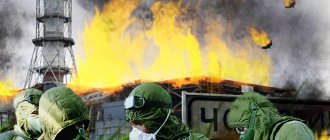Not all employees of large organizations and enterprises are aware of harmful working conditions and know what compensation is due. This issue can be sorted out thanks to the Labor Code of the Russian Federation, which specifies the threshold for dangerous working conditions and possible compensation.
Each employee whose position has a special rating, in addition to the main one, is entitled to additional paid leave for harmful working conditions. This period is at least 7 days.
Law
According to existing standards (Articles 116 and 117 of the Labor Code of the Russian Federation), the employer is responsible for providing additional leave to workers whose workplace is associated with negative factors. To do this, an assessment of working conditions must be carried out every 5 years .
IMPORTANT! Some situations require the employer to conduct an extraordinary special assessment. These are: an accident or the introduction of a new position in the staffing table.
According to federal law, namely Art. 14 from December 28, 2013 No. 426-FZ, a workplace can be assigned:
- Class 1 – acceptable conditions for work;
- Class 2 – working conditions are considered acceptable;
- Class 3 – the workplace is associated with harmful working conditions;
- Class 4 – the labor process poses a danger to the employee.
If an employee is hired for a position assigned grades 2-4, then he is entitled to additional leave in addition to the main one . You can obtain such information from the employer. Once the assessment is completed, the employee must sign the relevant document within one month.
Who can count on vacation for harmful activities?
A complete listing of positions and professions in which an employee must receive additional vacation days can be found in the List of industries, workshops, positions and professions with hazardous production factors. It was approved by the USSR State Statistics Committee back in 1974.
Currently, workers in the following industries are entitled to additional days of rest:
- mining industry;
- shale and oil and gas industry;
- work carried out underground;
- mining and processing;
- electrical power and chemical industries;
- microbiology;
- geological exploration;
- metallurgy, etc.
Who is entitled to additional days of rest by law?
Additional days of rest are provided not only to persons working in harmful and dangerous conditions. Company employees need to know the Labor Code of the Russian Federation. This will help them defend their rights.
The question of who is granted annual additional paid leave is relevant for many employees. After all, sometimes the standard duration of rest of 28 days is not enough to resolve all your affairs, restore strength and health.
Additional leave is due:
- employees whose work activities involve increased psychophysical stress and life risks. This category includes employees of the prosecutor's office, customs service, Ministry of Internal Affairs, military personnel and astronauts;
- persons extracting and transporting minerals;
- citizens who are employed in the construction industry, subject to constant work underground;
- employees in the healthcare and sports sectors. These are athletes, coaches, doctors;
- municipal, civil servants;
- regular divisions of the electrical power and metallurgical industries;
- persons who work in places with irregular hours;
- workers of the Far North and areas that are equivalent to this territory;
- employees who suffered during the liquidation of the consequences of the disaster at the Chernobyl nuclear power plant;
- citizens working in harmful and dangerous conditions;
- single mothers, adoptive parents;
- pregnant women, young mothers;
- people combining work and study.
Procedure for provision and registration
The duration of additional days of rest for work with hazardous production factors depends on how many months or years a particular employee has worked. Only those days that were worked in negative conditions are taken into account.
The billing period does not include:
- the time when the employee was on sick leave;
- leave related to pregnancy and childbirth;
- period of child care up to 3 years;
- the period when a pregnant woman was transferred to light labor;
- the period involved in the performance of government duties;
- other periods when the employee did not perform work in hazardous conditions.
The length of annual leave for harmful activities is proportional to the time worked. Leave cannot be granted in advance. The conditions for registering work experience (half or quarter of the rate) do not matter; this is confirmed by judicial practice.
Documents are prepared as follows:
- a schedule is developed in which, after agreement with the employee, the start and end dates of the vacation are entered (drawn up at least 2 weeks before the start of the next year);
- the employee must be notified of the vacation 15 days before it begins;
- if the schedule does not contain an exact date, but only the month, it is worth writing a statement to clarify the specific date.
The issue of registration of additional leave is dealt with by the HR department of the enterprise, where the leave sheet is compiled. Required documents:
- statement;
- order;
- note calculation.
Determining length of service for calculating additional leave
How is the length of service that gives the right to annual additional paid leave for work with harmful and (or) dangerous working conditions calculated? Annual leave (both main and additional) is provided to employees not for the calendar year (from January 1 to December 31), but for the working year. So, if an employee is hired on March 20, his working year will be the period from March 20 of the year of employment to March 19 of the following year (clause 1 of the Rules on regular and additional leaves, approved by the People's Commissariat of Labor of the USSR on April 30, 1930 No. 169, currently in force in part that does not contradict the Labor Code of the Russian Federation, Letter of Rostrud dated December 18, 2012 No. 1519-6-1).











